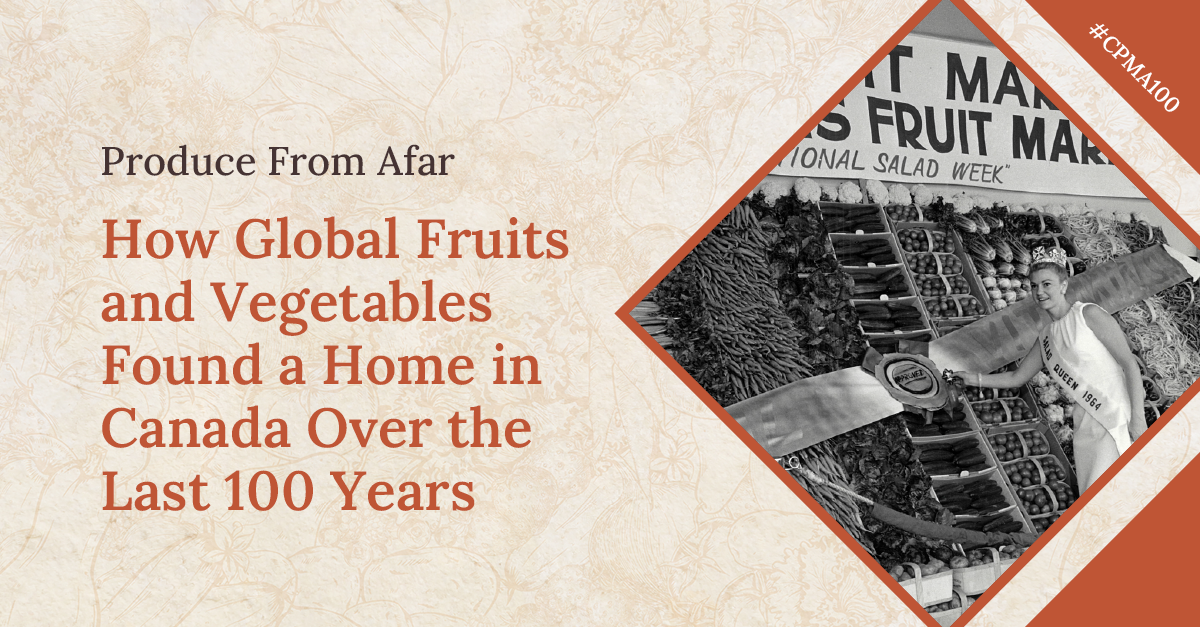Produce From Afar
CPMA
October 10, 2024

Canada's produce market has undergone a remarkable transformation over the last century. From a limited selection of local fruits and vegetables to a diverse array of global produce, the story of how these items found a home in Canada is both fascinating and illustrative of globalization's impact. The Canadian Produce Marketing Association (CPMA), celebrating its 100th anniversary, has played a pivotal role in this evolution.
The Early 20th Century: Limited Selection, Local Focus
Pre-1920s Overview
Prior to the 1920s, Canada's market was heavily reliant on locally grown and seasonal produce. Options were limited, and most Canadians had to make do with what was available in their immediate surroundings. During this period, apples were a staple, dominating the fruit selection due to their excellent storage capabilities. This reliance on local produce was largely driven by economic and technological limitations. Early trade routes were not as developed, and refrigeration technology was in its infancy, severely restricting the import of fruits and vegetables from distant regions.
Bananas: The First Global Fruit (1920s)
The 1920s marked a significant shift with the introduction of bananas, making them one of the first widely imported tropical fruits in Canada. The Eastern Canada Fruit and Vegetable Jobbers, as the CPMA was known as at the time, played a crucial role in standardizing imports, ensuring bananas became a Canadian staple. Their affordability and convenience revolutionized fruit consumption, making them a household favourite. This period laid the groundwork for future imports, showcasing how global fruits and vegetables found a home in Canada.
Citrus Fruits: Oranges and Grapefruit Take Root (1930s-1940s)
Introduction of Oranges and Grapefruit
The 1930s and 1940s saw the introduction of citrus fruits, particularly oranges and grapefruit, imported mainly from the U.S. and Mediterranean regions. During World War II, nutrition campaigns emphasized the importance of vitamin C, boosting the popularity of these fruits. Clementines in particular found popularity due to their small size and ease of portability. By the 1940s, oranges had become one of the most imported fruits in Canada, reflecting how global fruits and vegetables not only found a home in Canada during challenging times but contributed to Canadians' diet.
Avocados: The Superfood of the 1980s
Initial Introduction
Avocados, once considered exotic, made their way to Canada in the late 1970s and gradually gained popularity in the 1980s. Marketed as a “superfood” due to their nutrient-rich content, they quickly became a staple in health-conscious and gourmet diets. Over the last 40 years, avocado consumption has more than tripled in Canada. This significant increase in consumption marks another milestone in how global fruits and vegetables found a home in Canada.
Mangoes and the Rise of Tropical Fruits (1990s-2000s)
Introduction of Mangoes in the 1990s
The 1990s marked the rise of tropical fruits like mangoes, initially introduced through immigrant communities. Canadians began to embrace global cuisines, and mangoes became a popular item in grocery stores nationwide. The significant increase in mango imports highlights the growing multicultural consumer base in Canada. Similar to other walks of life, immigrants have played a crucial role in contributing to the Canadian produce industry and helping it evolve to cater to growing, diverse tastes.
Kale and the Popularity of Superfoods (2010s)
Kale’s Surge in the 2010s
Although not an import, kale's rise in the 2010s mirrors the growing demand for health-conscious produce items. Social media trends and health influencers turned kale into a staple in Canadian diets. Between 2012 and 2015, kale imports surged due to rising demand in restaurants and homes. This trend complements the broader narrative of how global fruits and vegetables found a home in Canada, emphasizing the evolving tastes and health trends among Canadians.
Conclusion
Reflection on 100 Years of Produce Evolution
The last 100 years have seen a remarkable evolution in Canada's produce market. Thanks to globalization, trade, and agricultural innovations, a rich variety of fruits and vegetables are now available to Canadians. The CPMA has been instrumental in this transformation, ensuring that once-exotic produce finds a home in Canada.
CPMA’s Role in the Future
Looking ahead, the CPMA's role will continue to be critical as new trends emerge. Climate-friendly produce and innovative agricultural practices will shape the next 100 years of Canadian eating habits. For those interested in a deeper understanding of this fascinating history, exploring how global fruits and vegetables found a home in Canada offers valuable insights into the broader dynamics of trade, culture, and innovation.
By examining the past and looking forward to the future, we can appreciate the incredible journey of global fruits and vegetables finding a home in Canada. From apples to avocados, each step has contributed to the rich and diverse produce market we enjoy today.